|
It all starts so innocently, albeit with just a whisper of insipidity. On a cheery, sunny day, young Jennifer Stewart (Lucy Marlow) arrives from Chicago for her first ever visit to the plantation mansion of her middle-aged cousin, Eva Phillips (Joan Crawford). She’s welcomed in by the home’s friendly butler, Sam (Bill Walker), and has been in the hallway for only a few seconds when two young children excitedly descend the grand central stairway under the misapprehension that their mother is home. Young Trissa (Linda Bennett) is friendly in that icky way the kids often were in older Hollywood films, while her brother Ted (Tim Hovey) is an obnoxious little brat whose first words to Jennifer are a barked, “I don’t like you!” Worry not, because Trissa thinks Jennifer is great and wants to know it she and her are “kissing kin.” “Oh, I hope so,” replies Jennifer enthusiastically as the two peck each other on the cheek, a slice of gooey saccharinity that continues when Trissa accompanies Jennifer to her room, by when I was starting to wonder if it was wise to put this film on so soon after eating.
It's then that we get our first sign that all in the Phillips house is not the picture of familial sublimity suggested by this opening scene, when Eva’s sister-in-law Carol (Betsy Palmer) arrives home with her boyfriend, Jud Prentiss (John Ireland), in the midst of an argument about their engagement and the fact that Jud’s job seems to dictate everything he does. The two initially fail to see Jennifer standing on the stairs above them, and when they do, Jud reacts tersely to her presence and strides away, leaving Carol to make excuses for his anger and welcome Jennifer into the drawing room to meet the various individuals gathered there. First up is Sue McKinnon (Fay Wray), a close friend of the family who has never fully recovered from being jilted at the altar and is convinced that she knew Jennifer’s mother well, despite Jennifer’s insistence that the two women never met. Even more pleased to meet the young newcomer is Sue’s brother Ty (William Leslie), the sort of burly southern beau who probably tries it on with every woman he meets and who is described by Carol as “a terrible flirt and as wicked as he can be,” which surprisingly seems to interest their innocent-seeming Jennifer.
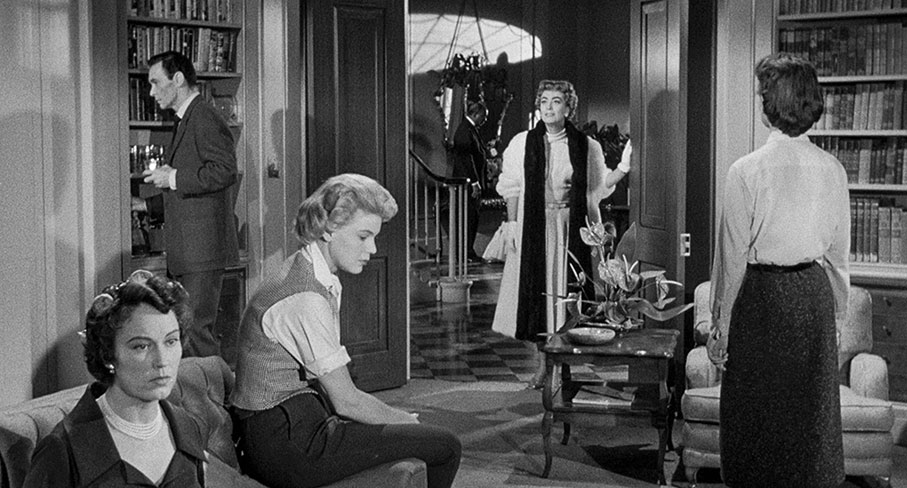
It’s a different story altogether with Carol’s brother and Eva’s husband, Avery (Barry Sullivan), who is known as ‘Beauty’ due his very visible facial scars, a cruel nickname that he wears with bitterness and drowns in heavy drinking. The kindly Jennifer then humours Sue’s delusions, but when she looks up at a portrait of the still absent Eva and dreamily asks if she is, “so very beautiful,” she fails to pick up on the cool response of everyone else in the room. Even Sue turns away, telling Jennifer half-heartedly that that such an opinion would be “in the eye of the beholder.” Carol then lightens the mood, and is midway through entertaining Jennifer with comically mocking recounting of family history when a voice from the hallways reveals that Eva has arrived home, and the mood of the whole room darkens in an instant. “A delightful afternoon, suddenly complete,” says Avery sardonically as he turns to pour himself another drink. By this point, it has become clear that the overly sunny idyll suggested by the opening was a carefully crafted piece of misdirection, and while Jennifer still views Eva through the starriest of eyes, for the rest of the family it’s clearly a different story.
The manner in which Eva is negatively impacting the lives of the people who should be her nearest and dearest is indicated in the film’s title, which is referenced directly in the film itself when Carol, in her first attempt to warn Jennifer about Eva’s true nature, reveals that she once read a book about bees that described the queen bee as “the ruler of the hive… who stings all her rivals to death.” I’ll leave the specifics of how this applies to Eva for the film to reveal, but it soon becomes clear to the audience what an unpleasantly manipulative woman she can be. It takes a bit longer for Jennifer to accept that she is anything but a radiant saint, a frustrating delusion that you know is going to slap her in the face sooner or later, and I use that term in more than just its figurative sense.
Listening to the accompanying commentary by David Jenkins, I was once again reminded me how easily I get suckered in by plot twists that others can predict when I get really involved in a film, and an hour into Queen Bee I was blindsided by one that had me yelling at the screen in shocked disbelief. By this point I had indeed become wrapped up in the story and the characters, and particularly sympathetic to the plight of Carol and Jud, who initially have to keep their desire to marry a secret because they know it would meet with Eva’s disapproval, and that she would likely do what she could to torpedo their intentions. I was initially also infuriated by Jennifer’s rejection of all criticism of a woman that she has pictured even before she arrives as a glamorous paragon of goodness, and thus relieved when she approaches Avery for help with the admission that her eyes have finally been opened. And oddly enough, it’s the perennially unhappy Avery that I found myself connection to first, in in no small part because of Barry Sullivan’s nicely judged performance and the telling lines he’s gifted in the early scenes. When Eva blocks his passage to a whisky bottle, he warns her, “My dear, I’ve told you before, never come between me and my liquor, you’ll get knocked down,” and a few mornings later after he’s sobered up, he responds to Carol’s claim that Jennifer is not interested in his drinking with an almost upbeat, “Of course she is. Everybody’s interested in my drinking. It’s rather remarkable sometimes.” Once the real cause of the torment that drove him to the bottom of a bottle is revealed, he becomes a figure of genuine sympathy, and when Jennifer pleads for his help and he makes a rare stand against Eva as the head of the household, there’s a real sense that he could still turn his life around, despite clear signs that Eva is already plotting ways to undermine his dictum.
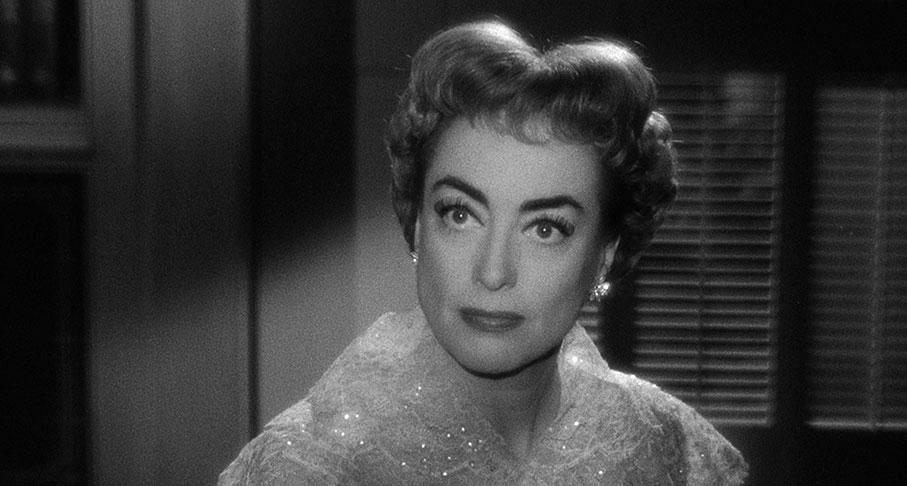
And then there’s Eva, the dark sun around which the other characters orbit, a destructive gravitational pull that they are seemingly unable or unwilling to break free from. As a character, Eva comes across as a heartless, narcissistic and self-centred control freak who expects everybody to bend to her will, and seems to know exactly how to force each of them to do so (remind you of anyone in the current political climate?), but as played with some relish by Joan Crawford, she’s a twisted joy to watch. Crawford really is on excellent form here, able to instil her sharp words with secondary meaning with a flick of her large and expressive eyes or the lilt of her scheming and self-satisfied smile. For me, this peaks with her suggestion to one character that her partner has been unfaithful, and when that person asks who with, the way that Crawford delivers the line, “Who do you think?” actually prompted me to omit a small squeal of delight, in spite of the calculated nastiness of her action. “Any man's my man if I want it that way,” she claims at one point, and it quickly becomes clear that these are not empty words, and that she is fully prepared to use her past affairs as weapons to manipulate those who fell, however briefly, under her spell. This is given symbolic representation when she makes a telephone call to lie her way out of a party date in order to stay in for an evening meal that will be unexpectedly attended by one of her past flings, and as she spins her yarn to the party host, she snares the man in question by casually looping the telephone cord around his neck and tightening it in the manner of an owner putting her dog on a choke leash. Intermittently, however, cracks in this confidently controlling façade briefly become visible. This first occurs when Eva recalls how the attitudes of others shaped her current personality and completely loses her rag in front of a distressed Jennifer, the second when she is delivered distressing news of a catastrophe that she was instrumental in triggering, and she expresses her furious despair by feverishly obliterating her reflection in a mirror with face cream.
As the one who first optioned Edna L. Lee’s source novel and requested that Mildred Pierce (1945) screenwriter Ranald MacDougall be brought on as this film’s writer and director, it’s not surprising that Crawford also gets her share of memorable lines, although their sting always comes from the context in which they are delivered and thus do not work as well as stand-alone written quotes. That said, I did smile widely when Eva swans into the drawing room and makes an affectionate move towards a former conquest who now wants nothing to do with her, and is suddenly made aware of Jennifer’s presence, to which she responds with a mock-friendly smile, “I didn’t see you. You’re so quiet. We’ll have to put a bell on you.” One of my favourite lines, however, is delivered by the past conquest in question (I’m trying to avoid dropping spoilers here, hence the lack of names), when he reacts to Eva’s seductive overtones with the priceless barb, “You're like some fancy kind of disease. I had it once. Now I'm immune.” This is nonetheless then undercut by Eva when she replies with venom, “I’ll make you sorry for this,” and you absolutely know that she means to make good on that promise.
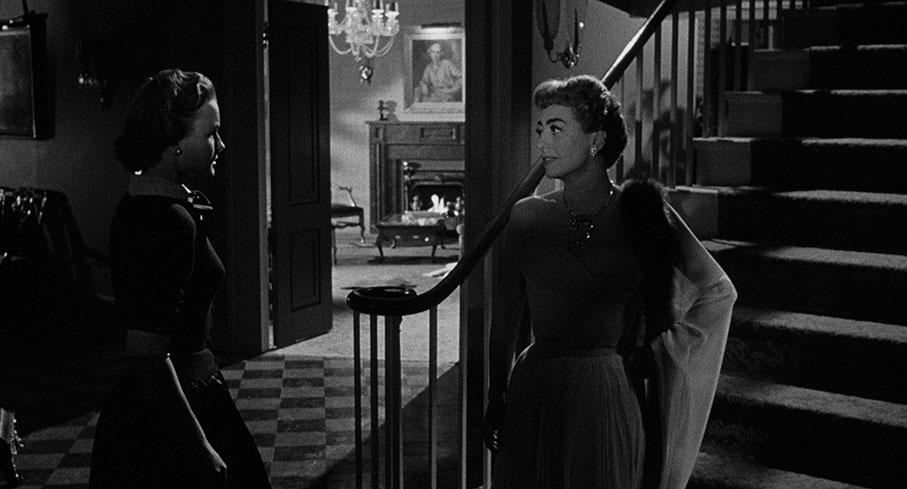
Crawford’s confidence in MacDougall both as a screenwriter and first-time director is really born out in the strong southern gothic vibe he brings to the melodrama, a task in which he is immeasurably aided by Ace in the Hole (1951), The Big Heat (1953) and The Man from Laramie (1955) cinematographer Charles Lang, another Crawford requested hire whom had she had worked with previously in on the psychological thriller Sudden Fear (1952) and the recently completed Female on the Beach (1955). His lighting camerawork here is exemplary, his precise framing and use of light and shadow expressing as much about Eva as her words and actions, plunging her into darkness for illicit meetings, and even providing her with a provocative entrance, when she slips into the shadows as she approaches the drawing room and emerges, initially smiling, into the light.
Of the four titles released by Indicator this month, there was something about the synopsis of Queen Bee that prompted me to pop that disc into my Blu-ray player first, and after being nicely misdirected by the smiley über-innocence of the opening scene, I found myself very quickly drawn into the resulting (melo-) drama and genuinely surprised by the dark directions it subsequently took. There are also signs here, in both the characters and the story development, that Hollywood was starting to break free of the constricting grip of the Production Code. Being a wealthy southern plantation home, it comes as no surprise that it is staffed by black servants, the most prominent of whom are Miss George (Willa Pearl Curtis) and the aforementioned Sam, but both are rounded characters, warmly presented and played, and are treated more as friends than servants by the more progressive city girl Jennifer. There’s also an attitude to extramarital flings and even potential long-term relationships here that I’m fairly certain would have been stamped on by the censor just a few years earlier, and I’m sure the morality police would have had something to say about the climactic scene and its immediate aftermath. It’s to the filmmakers’ credit that they were able to include these elements without diluting them or their impact, and they contribute greatly to a smartly written, captivatingly performed, splendidly photographed and impressively directed gothic melodrama that handsomely showcases Crawford at her bitchily manipulative and gloriously caustic best.
Sourced from an HD remaster by Sony and framed in its original aspect ratio of 1.85:1, the 1080p monochrome transfer on Indicator’s new Blu-ray is a typically strong one, with well-defined detail, slightly punchy but still well-graded contrast, and black levels that, although just a hair’s breadth shy of the deep black of the aspect ratio borders, are still solid and pleasingly consistent whatever the lighting situation. That there’s an overcast feel to many scenes set inside the house is clearly deliberate, a supposition confirmed by the far brighter opening and closing shots set in exterior sunshine. The transfer is clean of dust and damage and sits rock-solidly in frame, and the film grain is visible but never obtrusive.
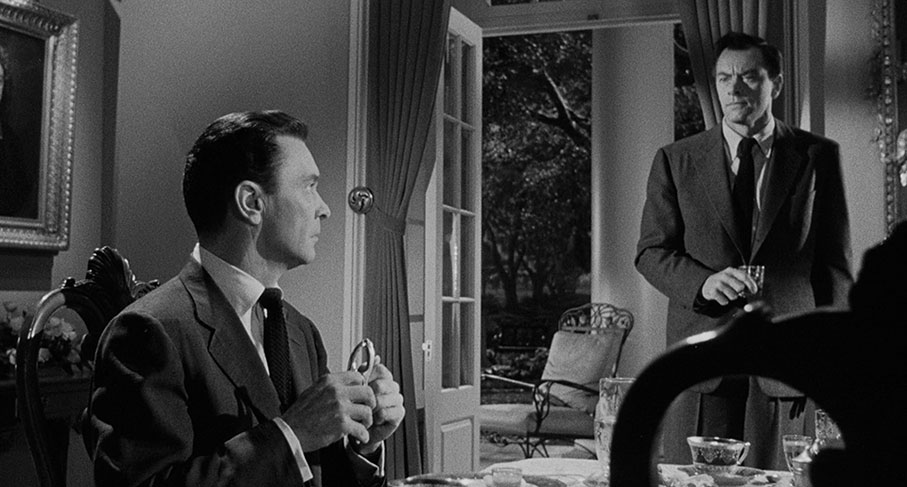
The original mono soundtrack is presented here in Linear PCM 1.0 and is also in good shape, with the expected, age-related limitations of the tonal range not impacting on the clarity of the dialogue or George Duning’s orchestral score. The track is also free of background hiss and fluff and any obvious signs of wear.
Optional English subtitles for the hearing impaired are available.
Audio commentary with David Jenkins
I know this is a personal thing, but editor of the excellent film magazine Little White Lies, David Jenkins, has the sort of gentle voiced delivery that I could listen to all day, and it helps no end that what he has to say about Queen Bee is consistently of real interest. He nicely describes it up front as “a film about illogical hatred, suppression of empathy, and a kind of innate self-preservation at all costs,” and makes observations about the sterility of the interior of the Phillips house that genuinely hadn’t occurred to me but makes complete sense, as well as using the telling phrase “Chekhov’s gun cabinet” to describe one particularly potent piece of furniture. He provides information on some of the actors, makes pertinent observations about several of the characters, finds connections to the 1950 Crawford film Harriet Craig (another of this month’s Indicator releases), provides justification for seeing this film as a harbinger of the notorious 1981 Joan Crawford biopic Mommie Dearest, and intriguingly likens Eva to the queen on a chess board, the piece with the greatest freedom, whilst other characters are like pawns with only restricted movement. There is much more of interest, and although there are some pauses, these do not last long and the quality of the content easily makes these brief waits worth it.
Lies Lanckman: A Sting in the Tale (18:21)
Professor and, I believe, media studies lecturer Lies Lanckman clearly has a real passion for cinema that comes across in droves in her informed and enthusiastic examination of Queen Bee. She explains just why the film should be considered a Joan Crawford production, draws connections to previous Crawford films Harriet Craig (1950) and Sudden Fear (1952), notes the links between the character of Eva and the actress who plays her, and suggests that there’s more to Eva than Crawford’s own description of her as “a total bitch.” There’s plenty more to enjoy and be illuminated by here.
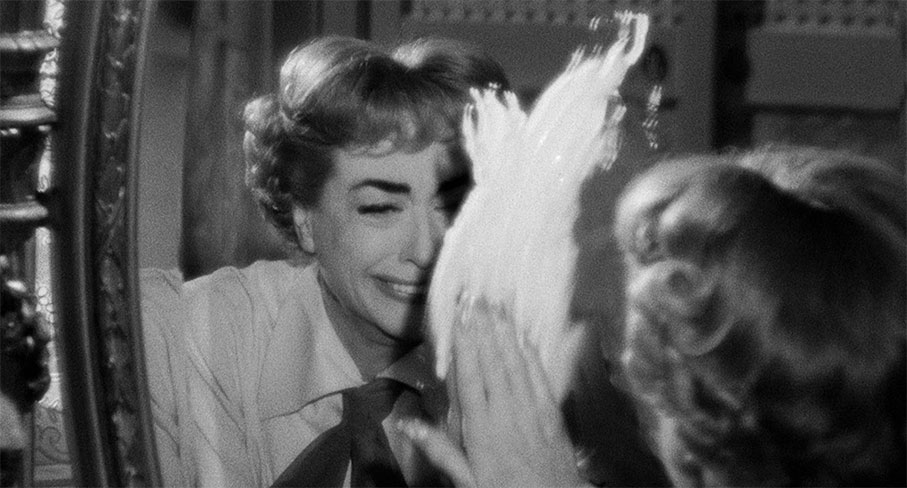
Nathalie Morris: Fit for a Queen (23:48)
I’ll be honest and admit that the notion of a 24-minute piece on Queen Bee’s Paris-born costume designer Jean Louis did not exactly have me bobbing up and down with excitement, so you could have knocked me down with a feathered gown when it proved to be a genuinely interesting and enlightening piece. After outlining how Louis made his way into Hollywood, Nathalie Morris takes us on a trip through his key early films, including his multi-film collaborations with Rita Hayworth, Kim Novak and Joan Crawford, pausing to discuss in some detail the now iconic strapless black dress worn by Hayworth in Gilda (1946). Inevitably and appropriately, the costumes in Queen Bee also get the once over before Morris moves on to the designer’s later work, which included stage costumes for Marlene Dietrich. A most surprisingly engaging watch.
Theatrical Trailer (2:42)
Opening with a dictionary definition of a queen bee, one that was probably invented by the publicity department, this very classic era Hollywood trailer gives a flavour of Eva’s character and her impact on those around her, but includes some spoilers, including footage from the climactic scene. The usual advice thus applies here – watch the film before giving this a look.
Image Gallery
78 screens of production photos, promotional portraits (including one in colour) and behind-the-scenes stills, plus two of Jean Louis’ costume design drawings and a range of posters.
French Photonovel
Back when I was a wee lad, there were magazines aimed at a teenage audience – primarily a female one if I remember right – that included, or were exclusively devoted to, stories told in the manner of a comic book but using photos instead of drawn artwork. This very approach was taken for a photonovel that appeared in a 1960 edition of the French periodical Les Films du Coeur, one that recreated the story of Queen Bee under its French title of Une Femme diabolique (effectively ‘A Devilish Woman’) using stills from the film alongside captions containing the French translation of the dialogue. Spread across 29 screens and presented as a series of two-page spreads, I rather enjoyed perusing through this, not least for the twinge of nostalgia it evoked.
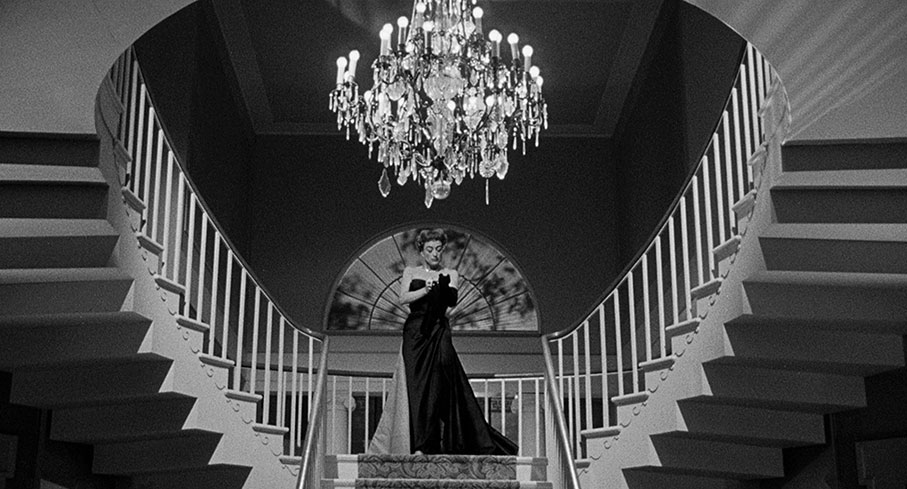
Booklet
The lead essay here is by New York based writer and film historian Imogen Sara Smith, who delivers an enjoyable and insightful look at the film, with particular emphasis on Joan Crawford’s performance as Eva and her career as an actor and the instigator of this project. I smiled at Smith’s description of Jean Louis’ more famous costume designs as “va-va-voom creations,” and there’s a really interesting examination of Eva’s character in relation to Molly Haskell’s book From Reverence to Rape: The Treatment of Women in the Movies. This is followed by an uncredited piece on the film and its making that quotes from several sources – including Joan Crawford, and author of the source novel, Edna Lee – and includes an extract from Christina Crawford’s famous exposé Mommie Dearest in which she claims that her mother’s performance was not acting but how she behaved towards her family. Extracts from several contemporary reviews have also been included, as have the credits for the film.
On its release, Queen Bee was – a tad condescendingly – categorised by several critics as ‘a woman’s picture’, and if that’s the case, maybe it’s my foetal female genes, but I became thoroughly engrossed by the film, its characters, its handling, and its talented cast. A melodrama, yes, but one infused with a dark streak of southern gothic that delivers some adult twists and a couple of genuinely startling moments. The presentation on Indicator’s Blu-ray is typically strong, as is the quality of the special features. Another easy Indicator recommendation.
|